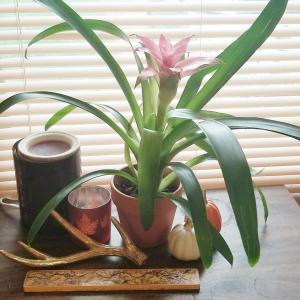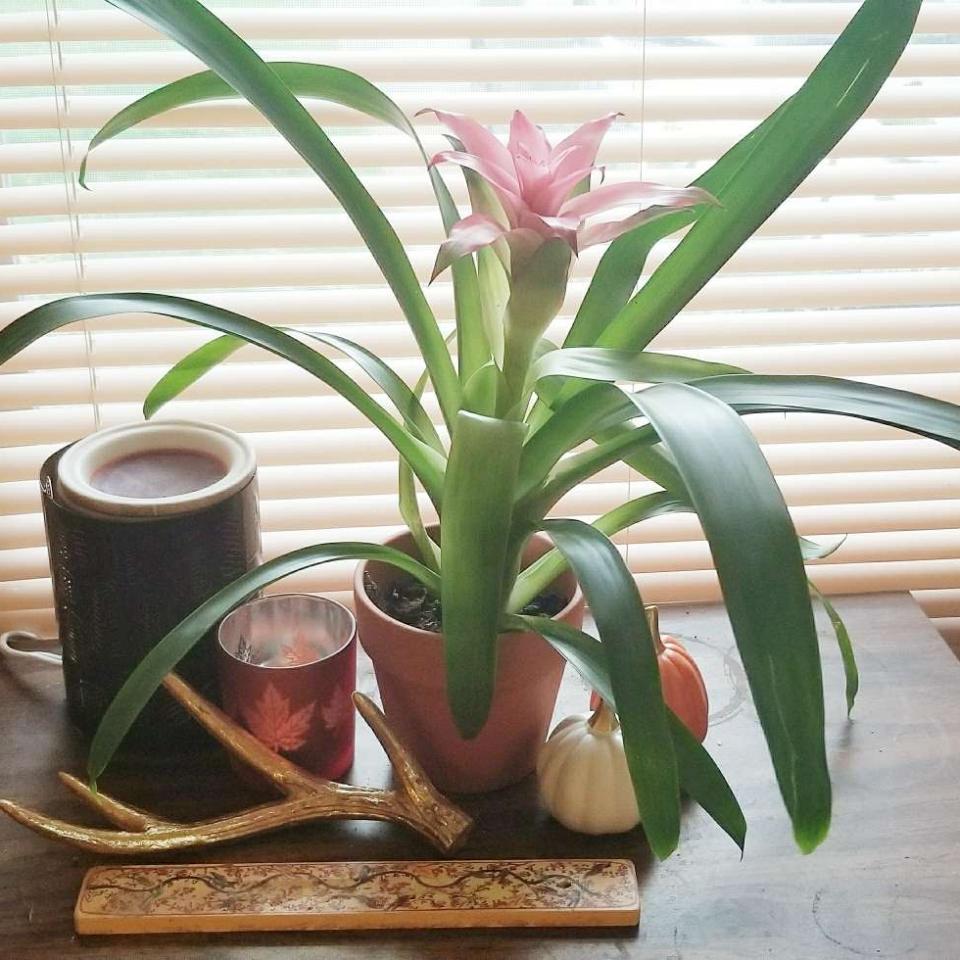Plant Experience
Detail
LIGHT
Bromeliad plants are very adaptable, and there is a variety for every light condition. If your bromeliad has thin green leaves it can survive in low light. If it t has thick gray leaves, it needs medium light. The flowers (colorful “bracts”) of a bromeliad plant fade quickly and the leaves turn pale green if it's placed in very bright light. The leaves get further apart and turn dark green when the plant needs more light.
WATER
Bromeliad plants are drought resistant succulents that like dry soil. These houseplants have very small roots and over-watering is the number one reason bromeliads die. Some have tanks that like being filled with water; others have fine hairs on their leaves that enjoy being misted.
FERTILIZER
Feed bromeliad plants by spraying a liquid fertilizer directly onto the leaves a few times each season. Dilute the plant food 1/2 to 1/4 the recommended strength. Never put fertilizer into the central cup of a bromeliad.
TEMPERATURE
Bromeliads are tropical plants that can survive in temperatures between 40-100 degrees, but prefer 70-75 degrees during the day and ten degrees cooler at night. The blooms on Bromeliad houseplants last longer when the temperature is cool.
HUMIDITY
Bromeliad plants grow well in basic household humidity.
FLOWERING
Less intense light and cooler temperatures help bromeliad flowers stay colorful longer. Indoor bromeliad plants bloom only once. As the bromeliad flower starts to die, the plant produces “pups,” baby plants around the base of the mother plant. Cut off the dying flower, so the plant can direct its energy to helping the pups grow.
PESTS
scale and mealy bug can be a problem for bromeliads.
DISEASES
Fungal plant diseases such as Crown, Stem and Root Rot, Rust Disease, and Leaf Spot may infectthe Guzmania variety of bromeliads.
SOIL
Use a light well-aerated fast draining soil. Add sand or perlite if the soil seems too heavy.
POT SIZE
During the spring, as a bromeliad matures and outgrows its existing pot, move the plant to the next size container After 3 or 4 years, when a bromeliad has reached maturity, it should remain in an 8’ pot. Bromeliads like to be root-bound in small pots so don’t rush to put them into a larger container.
PRUNING
Bromeliads rarely need to be pruned. If leaf tips turn brown, trim them with a sharp, wet scissors.
PROPAGATION
Once the bromeliad blooms die, small plants called offsets or pups grow around the base of the plant. When these offsetsare several inches tall, dig them out and plant them in a 4” pot of loose soil. Be careful not to over-water the new plants while the roots are developing.These new plants usually bloom in 1-3 years.
Bromeliad plants are very adaptable, and there is a variety for every light condition. If your bromeliad has thin green leaves it can survive in low light. If it t has thick gray leaves, it needs medium light. The flowers (colorful “bracts”) of a bromeliad plant fade quickly and the leaves turn pale green if it's placed in very bright light. The leaves get further apart and turn dark green when the plant needs more light.
WATER
Bromeliad plants are drought resistant succulents that like dry soil. These houseplants have very small roots and over-watering is the number one reason bromeliads die. Some have tanks that like being filled with water; others have fine hairs on their leaves that enjoy being misted.
FERTILIZER
Feed bromeliad plants by spraying a liquid fertilizer directly onto the leaves a few times each season. Dilute the plant food 1/2 to 1/4 the recommended strength. Never put fertilizer into the central cup of a bromeliad.
TEMPERATURE
Bromeliads are tropical plants that can survive in temperatures between 40-100 degrees, but prefer 70-75 degrees during the day and ten degrees cooler at night. The blooms on Bromeliad houseplants last longer when the temperature is cool.
HUMIDITY
Bromeliad plants grow well in basic household humidity.
FLOWERING
Less intense light and cooler temperatures help bromeliad flowers stay colorful longer. Indoor bromeliad plants bloom only once. As the bromeliad flower starts to die, the plant produces “pups,” baby plants around the base of the mother plant. Cut off the dying flower, so the plant can direct its energy to helping the pups grow.
PESTS
scale and mealy bug can be a problem for bromeliads.
DISEASES
Fungal plant diseases such as Crown, Stem and Root Rot, Rust Disease, and Leaf Spot may infectthe Guzmania variety of bromeliads.
SOIL
Use a light well-aerated fast draining soil. Add sand or perlite if the soil seems too heavy.
POT SIZE
During the spring, as a bromeliad matures and outgrows its existing pot, move the plant to the next size container After 3 or 4 years, when a bromeliad has reached maturity, it should remain in an 8’ pot. Bromeliads like to be root-bound in small pots so don’t rush to put them into a larger container.
PRUNING
Bromeliads rarely need to be pruned. If leaf tips turn brown, trim them with a sharp, wet scissors.
PROPAGATION
Once the bromeliad blooms die, small plants called offsets or pups grow around the base of the plant. When these offsetsare several inches tall, dig them out and plant them in a 4” pot of loose soil. Be careful not to over-water the new plants while the roots are developing.These new plants usually bloom in 1-3 years.
Album (1)

brielle
2017-09-10

Received this as a birthday gift from my brother Jon and sister in law Michelle on 9/10/17.


Elite Article













